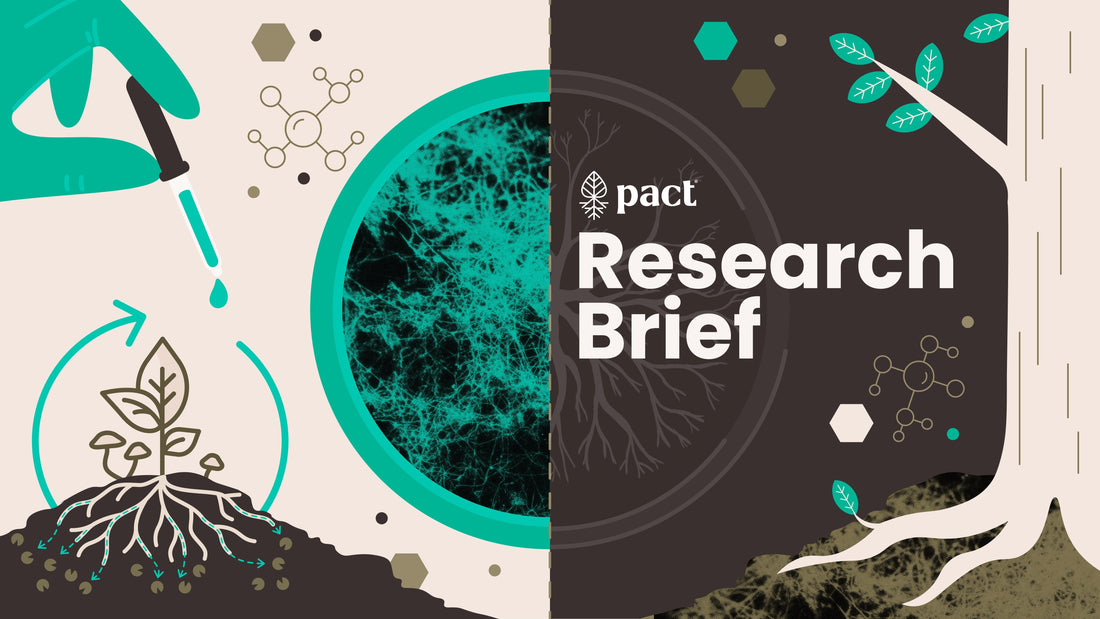
How Stropharia Supports Ecosystem Health
Share
Stropharia rugosoannulata, the species of fungi in PACT Tabs, is a saprotrophic fungi (or saprotroph), meaning it only breaks down dead and decaying organic matter. S. rugosoannulata is particularly specialized at decomposing wood, and is classified as a white-rot or litter-decomposing fungi that can break down both lignin and cellulose.
S. rugosoannulata is incredibly versatile, growing on forest floors, vegetable gardens, and even in containers or urban/suburban green spaces. They fruit in Spring through Fall where temperatures range from about 50-75 ℉, and can withstand sunlight.
It grows natively in Europe and the United States, and has been introduced to Asia, New Zealand, and Australia. S. rugosoannulata is considered a delicacy, and has been cultivated around the world for food purposes as well as the benefits it provides when grown alongside crops. Going further, S. rugosoannulata has been widely studied for a wide range of ecosystem services it provides to the environments in which it resides.
Soil Health & Nutrient Cycling
Fungi in the genus Stropharia support soil health and nutrient cycling through their decomposition activity (Nix 2022). Their role as saprotrophs—breaking down plant debris, wood, and other organic materials—provides nutrients to a wide variety of soil organisms. This fosters a complex micro-community that includes bacteria, other fungi, protozoa, nematodes, insects, and larger soil fauna like earthworms. By enriching the soil with organic matter and nutrients, Stropharia fungi indirectly support plant diversity, which, in turn, sustains the higher trophic levels like herbivores and predators.

The extracellular enzymes produced by S. rugosoannulata during decomposition are effective at digesting lignin and cellulose, the main components of most plant matter. Saprotrophs break down organic matter into their “building blocks” (proteins, carbohydrates, lipids, and/or nucleic acids) and consume the glucose, a carbohydrate sugar.
The rest of the broken-down organic matter is left in the soil, where it can be easily taken up by plants or other microbes and decomposers. Saprotrophs like S. rugosoannulata are important to the overall ecosystem functioning and nutrient cycling, as they convert unusable compounds into accessible forms of macronutrients and micronutrients (various elements, metals, molecules, and minerals) that can be used by the surrounding organisms.
These fungi are necessary for energy and nutrient cycling. In an ecosystem without decomposers, energy and nutrients would be lost to the environment and the ecosystem would fail as most plants cannot easily uptake or use organic matter until it is broken down (chemically) by other organisms like Saprotrophic fungi.
Biodiversity
Stropharia species increase biodiversity as well. Fungal hyphal networks serve as microhabitats (Hoosein et al. 2023), offering substrate for colonization by smaller fungi and bacteria. This promotes microbial biodiversity by creating a mosaic of micro-environments with varying levels of moisture, nutrients, and protection within the soil (Wagg et al. 2019). Stropharia species can suppress pathogenic fungi and nematodes by outcompeting them for resources, through chemical interactions, or, in the case of S. rugosoannulata, mechanical force by specialized cells called acanthocytes (Luo et al. 2006), allowing beneficial soil microbes and plants to flourish.
Additionally, Stropharia fungi can form associations with plant roots, benefiting plants (Bender 2022) by suppressing soil pathogens and outcompeting harmful fungi. From an agricultural and permaculture perspective, Stropharia rugosoannulata is often cultivated deliberately for its dual role as a food source and a natural enhancer of soil health (Gong 2018). This makes Stropharia fungi not only vital contributors to natural ecosystems, but also valuable allies in sustainable land management.
Carbon Sequestration
Saprotrophic fungi, like S. rugosoannulata, play a vital role in carbon sequestration by breaking down organic matter and incorporating carbon into their biomass and the surrounding soil (Emilia Hannula and Morriën 2022) (Reynolds 2024). As they decompose plant debris, wood, and other organic materials, a portion of the carbon is converted into building fungal tissues, including hyphae and fruiting bodies, which store carbon temporarily. Decomposition enriches the soil with stable organic compounds, creating humus, which can lock carbon in the soil for long periods. This process not only reduces the amount of carbon released as CO₂ into the atmosphere, but also enhances soil fertility, creating a feedback loop that supports plant growth and further carbon capture.
Mycoremediation
S. rugosoannulata, also known for its mycoremediation potential— has demonstrated the ability to break down harmful pollutants such as hydrocarbons found in fossil fuels (Steffen et al. 2002), pharmaceuticals (Castellet-Rovira et al. 2017), E. coli (Taylor et al. 2015), and other toxic chemicals (Valentín et al. 2013), helping to clean up contaminated environments. S. rugosoannulata further enhances biodiversity by breaking down pollutants in contaminated soils and creating conditions where sensitive species can return and thrive.
S. rugosoannulata’s lignin modifying enzymes (LME) for wood decomposition are not highly specialized or limited to breaking down wood, allowing the species to degrade other types of compounds.
As stated in a 2018 study, S. rugosoannulata is able to degrade “a wide range of structurally different environmental pollutants such as polycyclic aromatic hydrocarbons…synthetic anthraquinone dyes containing condensed aromatic rings, environmentally relevant alkylphenol, and oxyethylated alkylphenol representatives, and oil”. White-rot fungi, which includes S. rugosoannulata, are also known to remove pharmaceutical-derived pollutants and antibiotics (Pozdnyakova, et. al., 2018).
Many of the compounds mentioned above are ever-present in human waste (and toilet tissues), making S. rugosoannulata ideal for the mycoremediation of human waste in the backcountry. But, what about the bacterial coliforms found in human waste? E. coli and other coliform bacteria are among the biggest challenges with human waste in the outdoors [(Goodwin et al. 2012)(Derlet et al. 2008)].
S. rugosoannulata’s ability to remove E. coli bacteria from contaminated soil or water has been studied and is referenced above. In addition, a forthcoming study led by Colorado Mountain College and funded by PACT Outdoors, found S. rugosoannulata-enhanced soil treatments had a mean E. coli reduction of -89.42% in 3 days, while the control group showed a mean increase in E. coli of +71.37%. This difference in mean percent change provides strong preliminary evidence of the mycelium’s antibacterial properties, effectively reducing E. coli in concentrations of soil (Seitzinger 2025).
Fungal Diversity
The diversity and abundance of fungi are decreasing in the United States, and globally. Fungal diversity faces significant threats from climate change, urbanization, deforestation, wildfires, and agriculture. These factors, when combined, reduce fungal diversity and abundance with cascading effects on their ecosystems (Gibbens 2021).
Climate change disrupts fungal life cycles and habitats by altering temperature, precipitation, and seasonal patterns (Nic Lughadha et al. 2020). Urbanization fragments natural habitats, pollutes ecosystems, and limits the spread of fungi (Nic Lughadha et al. 2020). Deforestation and logging destroy forests, removing essential habitats for fungi (Chen et al. 2019) (Hartmann et al. 2012). Wildfires, particularly uncontrolled, high-intensity burns, devastate fungal populations by destroying their habitats, harming fungal reproduction, and also altering soil conditions and nutrient availability (Peay et al. 2009). Agriculture also poses a threat through habitat conversion, pesticide use, and soil degradation, which harm fungal communities that play key roles in nutrient cycling and soil health and stability.
The loss of saprotrophic fungi would significantly harm ecosystems by disrupting the decomposition process essential for nutrient cycling. Without them, organic material would accumulate in unusable forms, leading to nutrient depletion in the soil and a decline in plant productivity. This would create a cascading effect, impacting food webs, biodiversity, and overall ecosystem stability. Their absence would contribute to increased greenhouse gas emissions as well, because of the large role saprotrophs play in carbon sequestration.
Summary
The Saprotrophic class of fungi and Stropharia rugosoannulata, specifically, plays essential and far-reaching roles in our ecosystems. They are essential in the decomposition of organic matter and by extension soil health and nutrient cycling which all organisms depend on for survival. Through this process they contribute to the biodiversity of ecosystems spanning all trophic levels. Through their nutrient cycling process they support carbon sequestration which in turn supports more plant growth and more carbon capture.
On the human-induced side, S. rugosoannulata has demonstrated the capacity to break down numerous kinds of environmental pollutants from fossil fuels and pharmaceuticals to E. coli, and likely has a significant role to play in the decontamination of soils.
Bibliography
-
Castellet-Rovira F, Lucas D, Villagrasa M, Rodríguez-Mozaz S, Barceló D, Sarrà M. 2017. Stropharia rugosoannulata and Gymnopilus luteofolius: Promising fungal species for pharmaceutical biodegradation in contaminated water. J Environ Manage. 207:396–404. doi:10.1016/j.jenvman.2017.07.052. - LINK
-
Chen J, Xu H, He D, Li Y, Luo T, Yang H, Lin M. 2019. Historical logging alters soil fungal community composition and network in a tropical rainforest. For Ecol Manage. 433:228–239. doi:10.1016/j.foreco.2018.11.005. - LINK
-
Derlet RW, Ali Ger K, Richards JR, Carlson JR. Risk Factors for Coliform Bacteria in Backcountry Lakes and Streams in the Sierra Nevada Mountains: A 5-Year Study. Wilderness & Environmental Medicine. 2008;19(2):82-90. doi:10.1580/07-WEME-OR-1511.1 - LINK
-
Emilia Hannula S, Morriën E. 2022. Will fungi solve the carbon dilemma? Geoderma. 413(115767):115767. doi:10.1016/j.geoderma.2022.115767. - LINK
-
Gibbens S. 2021 Mar 18. Fungi are key to our survival. Are we doing enough to protect them? Natl Geogr Mag. - LINK
-
Goodwin, K., Loso, M. G., & Braun, M. (2012). Glacial Transport of Human Waste and Survival of Fecal Bacteria on Mt. McKinley’s Kahiltna Glacier, Denali National Park, Alaska. Arctic, Antarctic, and Alpine Research, 44(4), 432–445. - LINK
-
Hartmann M, Howes CG, VanInsberghe D, Yu H, Bachar D, Christen R, Henrik Nilsson R, Hallam SJ, Mohn WW. 2012. Significant and persistent impact of timber harvesting on soil microbial communities in Northern coniferous forests. ISME J. 6(12):2199–2218. doi:10.1038/ismej.2012.84. - LINK
-
Hoosein S, Neuenkamp L, Trivedi P, Paschke MW. 2023. AM fungal-bacterial relationships: what can they tell us about ecosystem sustainability and soil functioning? Front Fungal Biol. 4:1141963. doi:10.3389/ffunb.2023.1141963. - LINK
-
Luo H, Li X, Li G, Pan Y, Zhang K. 2006. Acanthocytes of Stropharia rugosoannulata function as a nematode-attacking device. Appl Environ Microbiol. 72(4):2982–2987. doi:10.1128/AEM.72.4.2982-2987.2006. - LINK
-
Nic Lughadha E, Bachman SP, Leão TCC, Forest F, Halley JM, Moat J, Acedo C, Bacon KL, Brewer RFA, Gâteblé G, et al. 2020. Extinction risk and threats to plants and fungi. Plants People Planet. 2(5):389–408. doi:10.1002/ppp3.10146. - LINK
-
Nix J. 2022. The role of fungi in a healthy soil microbiome. Biomemakers.com. - LINK
-
Peay KG, Garbelotto M, Bruns TD. 2009. Spore heat resistance plays an important role in disturbance-mediated assemblage shift of ectomycorrhizal fungi colonizingPinus muricataseedlings. J Ecol. 97(3):537–547. doi:10.1111/j.1365-2745.2009.01489.x. - LINK
-
Pozdnyakova, N., Schlosser, D., Dubrovskaya, E. et al. The degradative activity and adaptation potential of the litter-decomposing fungus Stropharia rugosoannulata. World J Microbiol Biotechnol 34, 133 (2018). - LINK
-
Reynolds M. 2024. The world’s largest fungus collection may unlock the mysteries of carbon capture. Wired. - LINK
-
Seitzinger, S., Hasdelhorst, M. (2025). Mycoremediation in the Backcountry: Fungal Solutions for Escherichia coli-contaminated Soils. [Manuscript submitted for publication]. Department of Ecosystem Sciences, Colorado Mountain College.
-
Steffen KT, Hatakka A, Hofrichter M. 2002. Removal and mineralization of polycyclic aromatic hydrocarbons by litter-decomposing basidiomycetous fungi. Appl Microbiol Biotechnol. 60(1–2):212–217. doi:10.1007/s00253-002-1105-6. - LINK
-
Taylor A, Flatt A, Beutel M, Wolff M, Brownson K, Stamets P. 2015. Removal of Escherichia coli from synthetic stormwater using mycofiltration. Ecol Eng. 78:79–86. doi:10.1016/j.ecoleng.2014.05.016. - LINK
-
Valentín L, Oesch-Kuisma H, Steffen KT, Kähkönen MA, Hatakka A, Tuomela M. 2013. Mycoremediation of wood and soil from an old sawmill area contaminated for decades. J Hazard Mater. 260:668–675. doi:10.1016/j.jhazmat.2013.06.014. - LINK
- Wagg C, Schlaeppi K, Banerjee S, Kuramae EE, van der Heijden MGA. 2019. Fungal-bacterial diversity and microbiome complexity predict ecosystem functioning. Nat Commun. 10(1):4841. doi:10.1038/s41467-019-12798-y. - LINK
